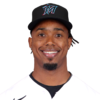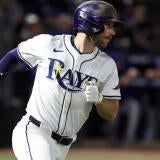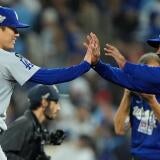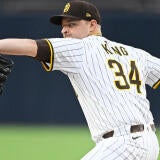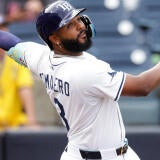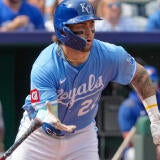Fantasy Baseball: Early second base rankings for 2017
Second base was stronger than ever in 2016, but being perceived as a deep position could actually work against it next year, according to Scott White.

Early 2017 rankings: 1B | 2B | 3B | SS | C | OF | SP | RP
In this same column one year ago, I lauded the improved depth at second base, saying it was a position where Fantasy owners could afford to wait because of a surplus of equally capable hitters.
I hadn't seen anything yet.
Those hitters haven't just been each other's equals. They've rivaled the best at any position, with one, Jose Altuve, emerging as an honest-to-goodness MVP candidate and another, Trea Turner, making the kind of impact we haven't seen from a rookie hitter since Mike Trout himself.
Just how much better has the position been this year? Well, last year, no second baseman averaged more than 3.21 Head-to-Head points per game. This year, 10 have.
Granted, that number owes something to the changing hitter landscape. Offense is up around baseball, reaching its highest levels since the peak of the steroid era, and it impacts every position from top to bottom. But this year was the first I can remember when starting a second baseman in a utility spot wasn't considered a glaring inefficiency that needed to be rectified through trade but common practice. Those trade opportunities didn't even present themselves because every owner was in the same boat.
So no need to extend yourself at the position next year, right? Well, for the most part. Second base is abounding in high-end hitters, sure, but some of the mid-round filler has evaporated. Players like Ben Zobrist, Jonathan Schoop, Joe Panik and Neil Walker dropped out of the discussion over the course of the season, and players like Anthony Rendon, Jose Ramirez, Eduardo Nunez and Addison Russell won't even be eligible at second base to begin 2017.
So while in theory, second base still offers more than enough high-end hitters to go around -- 13, by count -- that number could drop significantly if the multi-eligible players are all drafted to fill what are widely considered to be weaker positions, such as outfield, third base and shortstop.
Can't get too comfortable!
Top 10 second basemen for 2017:
1. Jose Altuve, 2B, Astros
2. Daniel Murphy, 1B/2B, Mets
3. Brian Dozier, 2B, Twins
4. Trea Turner, 2B/OF, Nationals
5. Matt Carpenter, 1B/2B/3B, Cardinals
6. Robinson Cano, 2B, Mariners
7. Rougned Odor, 2B, Rangers
8. Jean Segura, 2B/SS, Diamondbacks
9. Ian Kinsler, 2B, Tigers
10. DJ LeMahieu, 2B, Rockies
Quick note on Altuve: Though his newfound power has made him a better overall player this year, it has come at a price. Run-producers aren't asked to be table-setters, and since stolen bases are a by-request statistic, yeah, he doesn't have as many of those. And it seems to have coincided with his perceived change in role -- nine of his 27 stolen bases came way back in April. It's just something to keep in mind when you pick in the first half of this first round next year: Your stolen base needs won't be met with Altuve alone.
Will they with Turner, who has actually been the best player in Fantasy Baseball since arriving for good in mid-July? He has been Altuve's equal in stolen bases despite playing in less than half as many games -- and with similar home run power and batting average prowess. The danger is in accepting his numbers at face value even though he has less than a full season under his belt. Carlos Correa owners know how that works. By historical standards, the Astros shortstop has had an impressive sophomore campaign, but given that he was drafted under the precedent set by his rookie season, it's considered a disappointment in Fantasy circles.
I have no idea exactly how good Turner will be. The sum of his contributions I'm fairly confident will add up to elite production, seeing as he offers such a diverse skill set, but does he lose 20, 40 or 60 points on his batting average? And how legit is his power surge? Even his steals pace is well ahead of what he contributed as a minor-leaguer, but then that's a poor basis for comparison anyway. These are questions only time can answer, and seeing as second base offers no shortage of stud hitters, I'm thinking better safe than sorry.
That's not to say Murphy and Dozier are worry-free, but I feel like I can explain their monster production a little easier than I can Turner's, which makes me more inclined to believe in it. Murphy especially has validated his since it dates back to last September and can be attributed to a new stance and an improved approach. Plus, his batted-ball profile makes him a legitimate batting title threat. Dozier is all power, which gives him the lowest floor of the three, but he should be all power as a dead pull hitter with a fly-ball stroke. It hadn't gone as swimmingly for him in past seasons, but some health issues likely skewed those numbers.
I would say that of the three, Murphy is the safest but Turner the most promising, and I could be convinced to rank them in any order. For what it's worth, my Twitter followers were also torn on the matter:
Let's take a poll! Second at second next year. Who you got?
— Scott White (@CBSScottWhite) September 21, 2016
Not much to say about Carpenter and Cano. They're on the wrong side of 30 and coming off front-loaded seasons, which keeps them out of the elite tier even though they have comparable upside. Carpenter's struggles I think were largely injury-related, but he's more likely to be drafted as a third baseman anyway.
So let's talk about Nos. 7-12, which is where the real controversy begins. At least in points leagues, Odor has actually been the worst of Nos. 7-10 this season -- and in a way that puts his Rotisserie upside in question as well. His walk rate isn't just bad; it's the worst among qualifying hitters this year. Adam Jones has managed to make such a rate work for him over the years, but the number of high-end hitters to do so is a short one.
Then you have Segura, who has faked us out in the past, but by adding some loft to his swing this season, seems to have developed into the sort of multi-faceted player Fantasy owners crave.
And I'll admit my first instinct was to rank him ahead of Odor, knowing how valuable stolen bases are. Segura has been the better of the two this year, after all, and I'm not really sure how Odor can improve if he's already hitting 30-plus homers and giving away so many of his at-bats. But when the results are this lopsided, how can I not rethink my stance?
Working on 2B rankings for 2017 and overwhelmed by the depth. I'll need the help of the "perception" variable to differentiate. So ...
— Scott White (@CBSScottWhite) September 20, 2016
So here's what I've decided: Odor is doing what he's doing at age 22, which puts him in rare and elite company. He's already well ahead of the curve developmentally, so fixating on the areas of his game that aren't as developed may be missing the forest for the trees. It's possible the walk issue takes care of itself as pitchers learn he's a hitter to fear.
Like Carpenter and Cano, Kinsler is an aging player coming off a front-loaded season, but he's on the older side of "aging" and has shown clearer signs of concern in the past. Probably best to play it safe with him.
The drop-off from Muphy and Dozier to Kinsler still isn't so bad, especially factoring in some modest regression for those first two, so this list of 10 may only be subdivided into two tiers. Understand, though, that if Murphy is drafted to play first base, Turner outfield, Carpenter third base and Segura shortstop -- a plausible scenario, with Murphy being the one test of the imagination -- only half of a 12-team league's second base spots will be filled by this point.
Which will make this second list very much in play on Draft Day.
Next 10 second basemen for 2017:
11. Jason Kipnis, 2B, Indians
12. Dee Gordon, 2B, Marlins
13. Dustin Pedroia, 2B, Red Sox
14. Ben Zobrist, 2B/OF, Cubs
15. Devon Travis, 2B, Blue Jays
16. Logan Forsythe, 2B, Rays
17. Jonathan Schoop, 2B, Orioles
18. Joe Panik, 2B, Giants
19. Neil Walker, 2B, Mets
20. Ryan Schimpf, 2B, Padres
LeMahieu and Kipnis should inspire some debate in the coming months, and for now, I'm going against the consensus.
This 2B dilemma is subtitled "How much stock do we put in a .349 batting average?"
— Scott White (@CBSScottWhite) September 20, 2016
For me, it's an upside thing. If we operate under the premise that 2016 is as good as it gets for both -- and given their ages and peripherals, yeah, that's how I see it -- LeMahieu's best is better than that of Kipnis. You could argue it's less repeatable given its dependence on a high BABIP, but he's a line-drive, opposite-field hitter playing half his games at Coors Field, a home run-friendly park but also an enormous one. A high BABIP comes with the territory.
Format probably comes into play here since LeMahieu has the superior plate discipline that counts for so much in Head-to-Head leagues but lacks the home run power so vital to Rotisserie owners. That's even more apparent for the next man up, Gordon, whose stolen base prowess could move him up as much as three spots in Rotisserie leagues.
He was far and away the most difficult player to rank at this position. Consider the facts: He's a one-dimensional hitter whose one dimension (speed) happens to be the scarcest and most in demand in Rotisserie leagues. His last full season was of the too-good-to-be-true variety but still earned him a second-round selection this year. He has scuffled this year over a smaller sample size, but one made smaller in a way that might explain the scuffling -- i.e., a PED suspension. So in other words, who the heck knows?
I thought for sure the screaming masses would instead opt for the surging Pedroia -- recency bias and all -- and was pleased to discover they only bolster my viewpoint.
I have a feeling this one is going to be a landslide (and probably not fair to compare across formats), but ... 2017 .. who you got?
— Scott White (@CBSScottWhite) September 20, 2016
Yup, Pedroia is the older, more fragile, less Coors-enhanced version of LeMahieu and best treated as the ultimate fallback option at a loaded position.
Because after him, I'm not sure I give a darn. Zobrist collapsed down the stretch as a 35-year-old, which could suggest the end is near. Travis, Forsythe and Schoop have their strengths and are all usable in a fill-my-middle-infield-spot sort of way, but Travis and Schoop have the same plate discipline issues as Odor, only without his youth and transcendent power.
Panik might be the sneakiest pick of the bunch, particularly in points leagues. He has walked more than he has struck out this year and has almost identical peripherals to last year, only with a batting average about 70 points lower. Still, back issues, like he had late last year, and concussions, like he has had this year, are disruptive enough that you shouldn't bank on a rebound.
After him, where's the upside? Schimpf has shown big power this year, but with the kind of strikeout and fly-ball rates that basically condemn him to a .220 batting average. Yoan Moncada won't be second base-eligible to begin the year, and the same is true for Jose Peraza. Unless you think Raul Mondesi is ready to break out or Javier Baez is owed everyday at-bats, second base could still get pretty lean in leagues with 15-plus teams.



